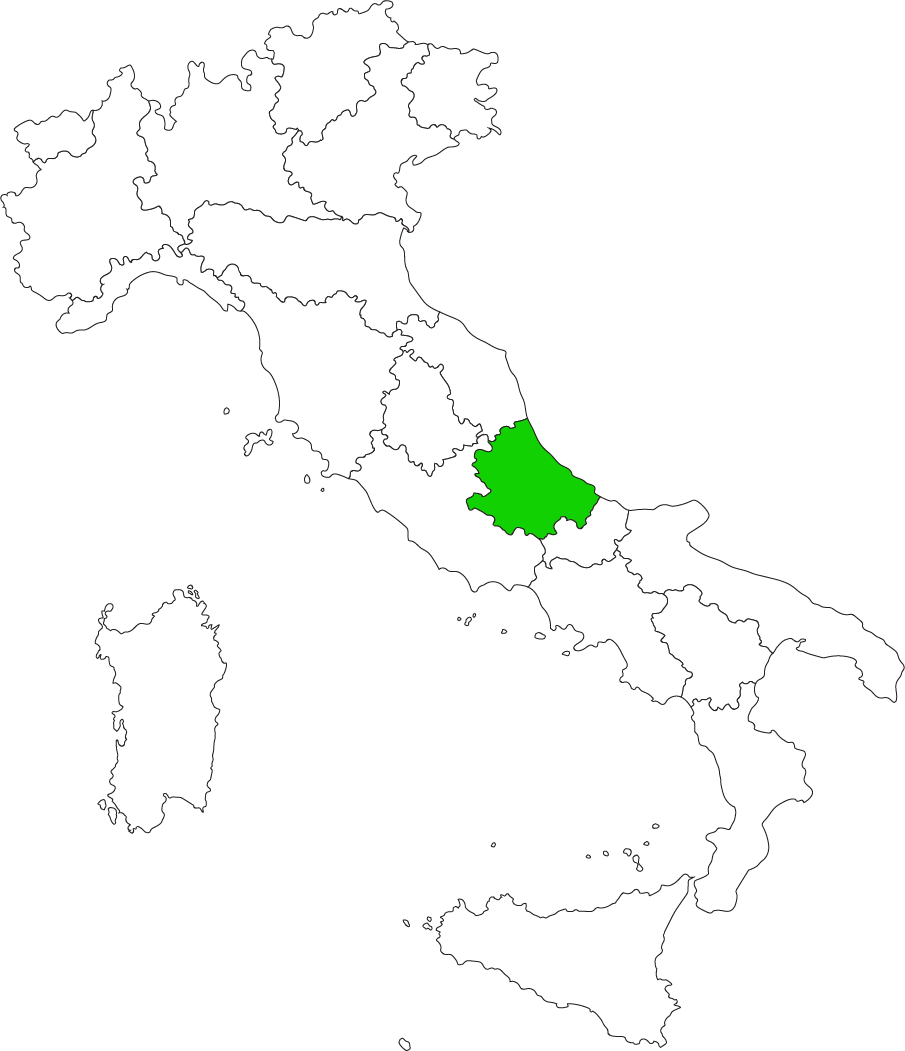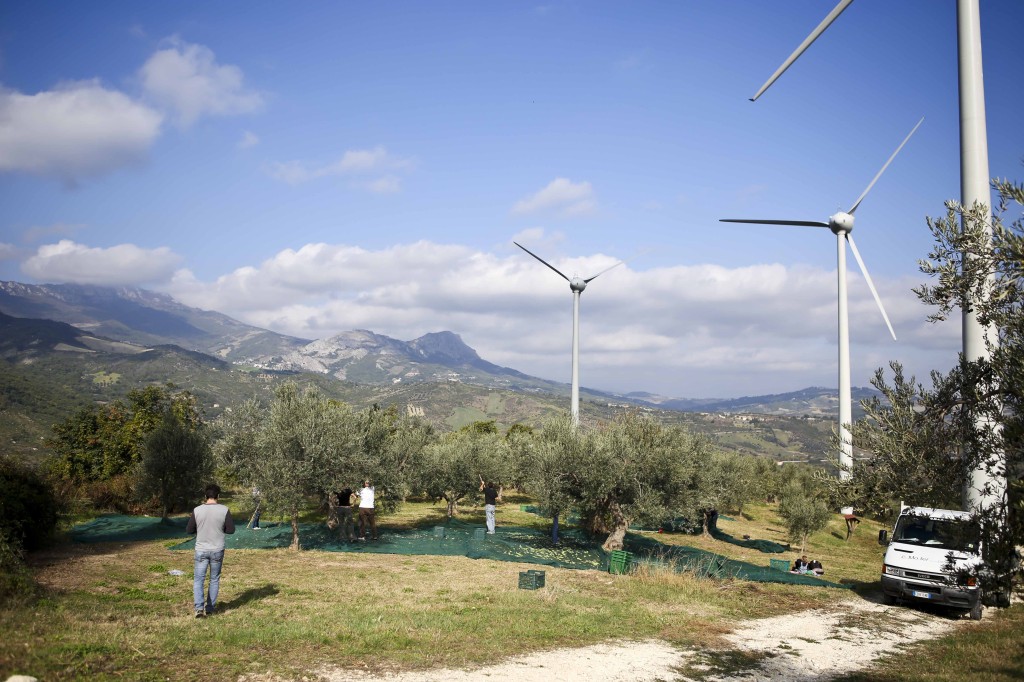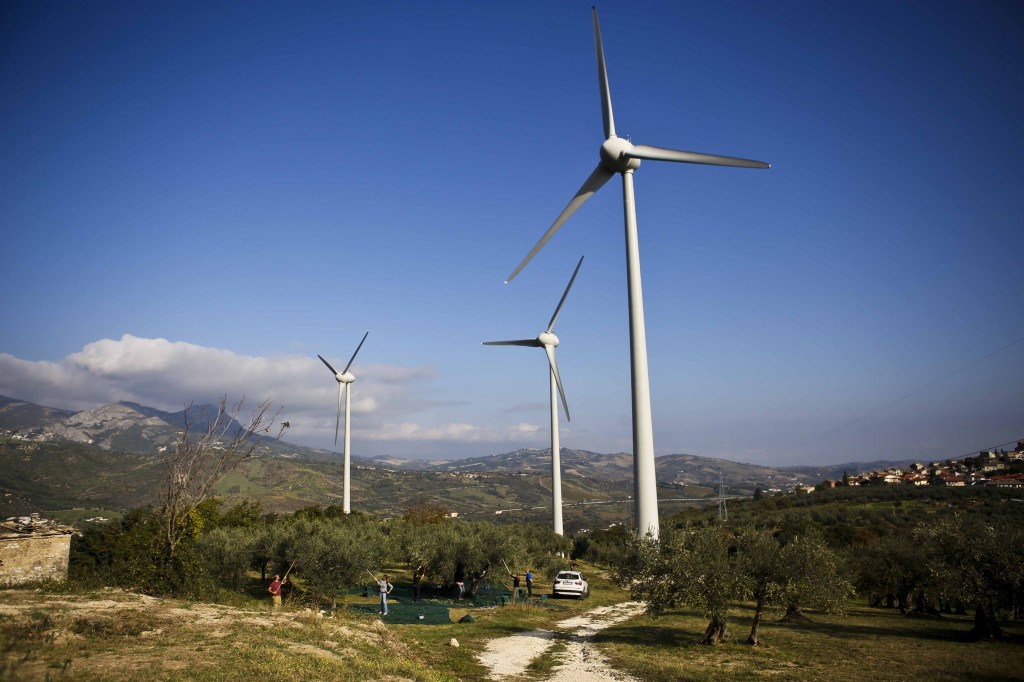Project Description
Tocco di Vento

Tocco di Vento

Where it is
Tuff cellars excavated into the rock, hundreds of year old vineyards, mountain walks and an enviable geographical position, in the point where the Maiella National Park, together with Mount Morrone ends, embraced by the Gran Sasso.
Welcome to Tocco da Casauria, a small village in the hinterland of Pescara known as the “the village of the wind” (“touching without selling is like the devil without teeth”, recites a local proverb). It is said that, up to a few years ago, when the weather had still not gone crazy and maintained its regular patterns, in Tocco da Casauria you could be certain to tell the exact time based on the wind’s direction, which, depending on the moment, could arrive from the Popoli Gorges, from the sea or blow down from the Majella.
| Legend |
|---|
 Wind Farm Wind Farm |
Browse the map and discover the places to visit, where to eat and where to stay, chosen by Legambiente

The wind farm
It is the place chosen for a modern wind farm, one of the very first in Italy, which has contributed to improving the economic life and revolutionized the environmental awareness of its inhabitants. The story of Tocco was made famous in a front page article of The New York Times in 2010 with the title, “Ancient Italian town has wind at its back”, bringing international fame to the village and resulting in a continual wave of tourists, still today. A small-big green revolution for this village of little more than 2,000 souls where, immediately after the Unification of Italy, the first Italian oil wells were constructed (third in the world after the USA and Romania), when it was discovered that the water table had brought tar to the surface from the depths of the mountain.
Today, instead, the story of Tocco is closely linked to renewable energy. “We were the first municipality of under 5,000 inhabitants, and one of the first in Abruzzo, to begin with door-to-door garbage collection. And thanks to the funds from the wind farm we have improved our services without burdening the cost on our citizens, using photovoltaic installations for public lighting, and we have been the first in our area to begin the digitalisation of the primary and intermediate schools”, recounts the mayor, Riziero Zaccagnini.
However, you can’t live by wind alone. To know Tocco da Casauria also means mentioning the toccolana, a native cultivar that owes its name to its place of origin. It is an olive tree that is well-suited to this micro-climate, where the wind constantly sweeps away any hint of humidity, and which produces a sophisticated extra-virgin DOP olive oil, with bitter and tangy notes, that is one of the local excellences for export. “There are about 80,000 hundreds of year old trees that do not take root in other parts, or do not produce fruit, and that only grow in this small area of Casauria”, explains Stefano Di Giulio, owner of a local farm. He is also one of the promoters of the association bringing together a network of producers with the purpose of adhering to and respecting a single production discipline and, at the same time, combining their efforts around a product that is representative of the area. Just one warning – in Tocco, you do not vulgarly taste the oil on a piece of bread, but you savour it as if it were a glass of champagne. To appreciate the nuances of its complexity and the diversity of its bouquet – from artichoke to cardoon to almonds.
Winemaking traditions
This village buffeted by the wind is also known for its wine tradition and its cellars, often found in ancient tuff caves. Some of these belong to Fausto Zazzera, who has all the right traits to be considered a 20th century figure. A no longer so young civil engineer, for almost 15 years now, he has begun using, at the beginning a hobby, then more seriously, a classic artisan method, using local vine varieties, that could be the envy of the more famous spumantis. The cultivation of the grapes, and the spumanti base, takes place on the hills of Crecchio, a medieval village in the province of Chieti. The spumanti vinification, instead, is carried out on an artisanal level (in the true sense of the word, to see is to believe) by Fausto Zazzara in his subterranean cellars in Tocco da Casauria.
The largest is a fantastic tuff cellar excavated out of rock dating back to the 15th century and, apparently, a time of the barons of Bonanni d’Ocre, who used to use it as an escape hole. The name of his company renders the idea of the figure quite well. It’s called Majgual (no two are the same) because friends continued to repeat that the spumanti was optimal but every bottle was different to the previous one. However, alas, it is about to change its name. He feels that foreigners would not be able to fully understand this sophistication. And maybe, a good glass of rosé could help to climb the mountain of Tocco and fly with outstretched arms before the wind admiring the village below and surrounding valleys. For a couple of decades now, the area, thanks to its strategic position, close to the massif of Morrone and being open to the sea, has become one of the focal points, also internationally, for paragliding with enthusiasts launching themselves from a natural shelf at an altitude of 600 metres.
Sustainability Trail
Instead, to discover the surrounding areas, another opportunity could be to take the “Sustainability Trail”, a project established two years ago by the cooperative Bosso, specialised in experience tourism (the canoe trip along the Tirino River is not to be missed). The 22 kilometre bike trail, well-marked and equipped with information signs, crosses the entire Casauria region. Passing through Tocco da Casauria, you cross the Torre de Passeri, where you must make a stop and visit the nearby San Clemente Abbey, follow the ancient route of the Via Claudio-Valeria – the common opinion is that the Centerbe, the local highly alcoholic liqueur made from an infusion of healing herbs, was produced the first time within the Benedictine walls – and you arrive at Bolognano, an ancient village perched on a hill overlooking the valley of the Orta River. A place that, other than being the realm of the wine Montepulciano d’Abruzzo, for a long period was an artistic outpost, thanks to the efforts of Lucrezia De Domizio Durini. She was a rather extravagant publisher and lover of contemporary art, known as the baroness, and was able with her creative energy to transform an entire village into an international culture venue. For a long period, the artist and sculptor, Joseph Beuys, also lived in Bolognano. The shaman of art, who, in that small village, found the ideal place to give full reign to his visionary idea of “social sculpture”. In 1999, the municipality dedicated a square to him, “Piazza Joseph Beuys”.
The Thermal Centre of Caramanico
Instead, for the mountain enthusiasts, we advise re-climbing to the Maiella National Park and making a stop, after 20 kilometres or so, at the old thermal spa centre of Caramanico – legend has it that it was Charlemagne’s grandson, the monk Caro, who founded the town – where the double healing properties of its thermal waters, sulphur and oligo-minerals, promise miraculous cures. From here, the more energetic can also embark on the trails of the “Cammino di Celestino”, an ideal trip in the tracks of the hermit Pietro da Morrone, the future Pope Celestine V, who chose the Maiella for his journey of faith. The tiring climb will certainly be repaid when you reach the top with magnificent views of the massif of the park and its steep ravines and valleys that climb up to the peak of Mount Amaro. It is really true that this corner of Abruzzo is the same as what they say about the bottles of Fausto Zazzera’s spumanti – not one (part) is the same.




